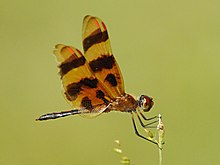Halloween Pennant
Celithemis eponinaSummary 3
The Halloween Pennant (Celithemis eponina) is a dragonfly found in North America, in the Pennant genus of dragonflies.
Halloween pennant 4
The Halloween Pennant (Celithemis eponina) is a dragonfly found in North America, in the Pennant genus of dragonflies.
Contents
Characteristics
The Halloween Pennant has been described as looking very similar to a butterfly. Its wings are orange-yellow in color, though its markings are dark brown, not black as is commonly believed; the entirely orange-yellow wings with dark brown bands are what has given it its Halloween common name[1] and its typical position of being perched at the tip of a weed stalk, waving in the breeze like a pennant contributes to the remainder of its common name.[2] The young has yellow markings, including a stripe on its back, and adult males develop pale red markings, particularly on the face, though females will occasionally get these red markings too. Halloween Pennants are normally between 38 and 42 mm (approx. 1.5 inches) in size.[3][4][5] They feed on other insects,[3] and they are able to fly in rain and strong wind.[4] On hot days, it will often shade its thorax using its wings.[5]
Location and habitat
They are commonly found in Central and east North America, particularly in Florida, where they are in season all year round. In the northern part of the range, they are in season from mid-June to mid-August.[3][5] They can range as far north as south of Canada and as west as New Mexico, but east of the Rocky Mountains. They particularly live around ponds, marshes and lakes, often perched on weedy stems.[4][6]
Reproduction
Females normally lay their eggs in the morning, in open water, whilst their mate is still attached to them by the head. This method is known as exophytic egg laying.[4][7] Sexual activity normally occurs between 8 and 10:30 am,[5] and males will normally wait for females to come to them around the edge of ponds, whilst perched on a weed.[3]
References
- ^Taber, Stephen Welton (2005). Invertebrates of Central Texas Wetlands. Texas Tech University Press. p. 56. ISBN 0-89672-550-2. http://books.google.com/books?id=sO6ax1TtnzEC&pg=PA56&dq=Halloween+Pennant+date:1991-2008&lr=&num=100&as_brr=0#PPA56,M1. Retrieved 31 October 2008. "The common name is a good one, for the wings are entirely orange-yellow with the exception of the bands, which are dark brown rather than black."
- ^Eaton, Eric R. (2007). Kaufman Field Guide to Insects of North America. HMCo Field Guides. p. 50. ISBN 0-618-15310-1. http://books.google.com/books?id=aWVi0IF_jcQC&pg=PA50&dq=Halloween+Pennant+date:1991-2008&lr=&num=100&as_brr=0. Retrieved 31 October 2008.
- ^ abcd"Species Celithemis eponina - Halloween Pennant". BugGuide. http://bugguide.net/node/view/2591. Retrieved 2008-10-22.
- ^ abcdWelton Taber, Stephen (2005). Invertebrates of Central Texas Wetlands. Texas Tech University Press. p. 56. ISBN 0-89672-550-2.
- ^ abcdDunkle, Sidney W. (2000). Dragonflies Through Binoculars. Oxford University Press US. p. 233. ISBN 0-19-511268-7.
- ^Eaton, Eric R. (2007). Kaufman Field Guide to Insects of North America. HMCo Field Guides. p. 50. ISBN 0-618-15310-1.
- ^Lawlor, Elizabeth P. (2000). Discover Nature in Water & Wetlands. Stackpole Books. p. 87. ISBN 0-8117-2731-9.
Sources and Credits
- (c) Ken Slade, some rights reserved (CC BY-NC), http://www.flickr.com/photos/10789832@N00/2668968240
- (c) Patrick Coin, some rights reserved (CC BY-NC-SA), http://farm6.static.flickr.com/5237/5843062678_c697a35d31.jpg
- (c) Wikipedia, some rights reserved (CC BY-SA), http://en.wikipedia.org/wiki/Celithemis_eponina
- (c) Unknown, some rights reserved (CC BY-SA), http://eol.org/data_objects/23499349








